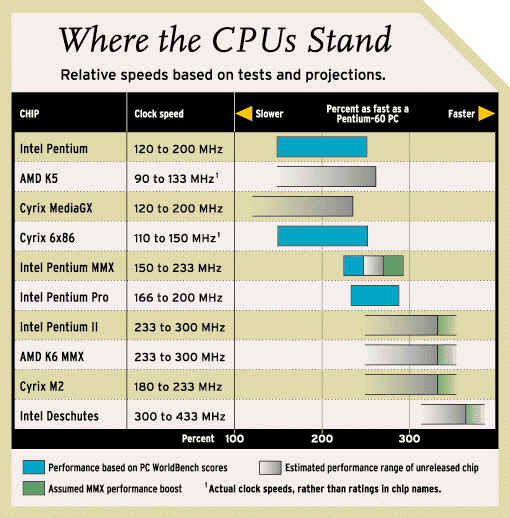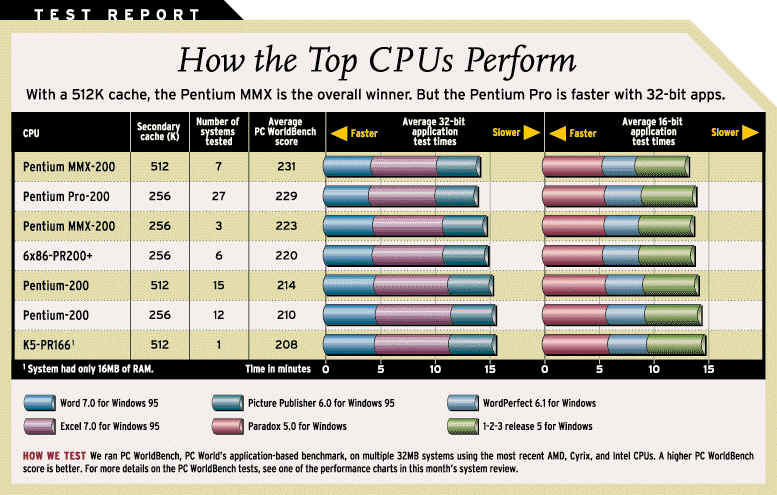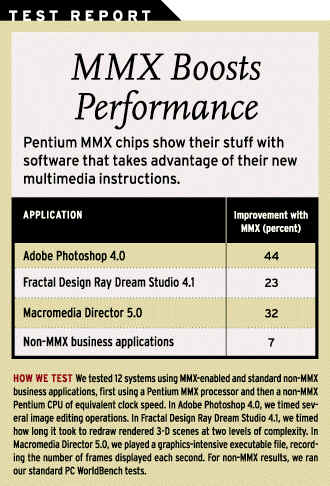Clock speed. It's no longer the criterion for judging CPU performance, but clock speed still means a lot. Every time the clock ticks (and in a 200-MHz CPU, it ticks 200 million times a second), some little chore gets done. All else being equal, the faster the clock ticks, the faster the chip finishes its work.
Cache memory. Inexpensive system RAM can't always feed a CPU the data it needs quickly enough, and a bit of faster SRAM in between the processor and the main memory improves things considerably.
This primary or level 1 cache is built into the CPU and runs at the chip's own internal clock speed, which makes it as fast as anything inside your computer. Intel and AMD split the primary cache of their processors into two sections--for instructions and data--allowing the CPU to quickly find each. In general, the larger the primary cache, the faster the chip.
Systems typically help the CPU with a larger amount of their own cache memory, called secondary or level 2 cache. In most cases, this cache resides on the motherboard and runs at that board's slower speed. To boost performance, the Pentium Pro comes with a built-in secondary cache, while the Pentium II and future Intel chips will put the cache in a package that bypasses the motherboard.
Architecture. A microprocessor's architecture, or structure, determines how it processes instructions and data. Modern CPUs use one or more multistage pipelines to process more than one instruction at a time. To keep a pipeline full and processing efficiently, a CPU will guess what instructions to handle next. If it guesses wrong, it must go back and perform the correct operations. The better designed the CPU, the less often this will happen.
Density. The tighter the transistors are packed, the faster the chip. The CPU needs to synchronize signals traveling among millions of transistors. Reducing the distance between transistors allows the chip to run at higher speeds.
Most of today's processors space their transistors .35 micron apart (a micron is about 1/100th the diameter of a human hair), which effectively gives them a 200-MHz speed limit. Intel, AMD, and Cyrix are all promising faster .25-micron chips by the end of the year.
Tighter design also reduces the amount of silicon needed to produce the chip, which helps keep manufacturing costs down and--theoretically, at least--lowers the cost to consumers.
Which chip is best for you? Here's what we know and what we predict about current and future CPUs.
We've limited the discussion here to x86 chips that can run DOS, Windows 3.x, Windows 95, Windows NT, and OS/2. There are also some high-end chips available that can run special versions of NT. For a discussion of them, see "NT Spoken Here".
Available Now
Endangered species list included silicon-based life forms, the original Pentium chip would be near the top. But this makes Pentium systems an excellent choice for bargain hunters. At press time complete Pentium PCs costing less than $1000 were just starting to appear. If you're outfitting a small office, use mostly business apps, and are trying to keep costs down, go with a Pentium.
Intel says that it will continue to make Pentium chips as long as there's a demand, and Pentium-based systems will probably be available throughout 1997. After that? One PC vendor who wished to remain anonymous told us, "Intel made it clear that by the end of the year there would be no more non-MMX P-200s shipped to us." Translation: Intel wants an MMX world.
AMD K5
When AMD's Pentium competitor first came out in March 1996, it was almost a year late and performed slower than expected. But AMD appears to have caught up. The one K5-PR166 system that the PC World Test Center has tested, Polywell's Poly500Qx (no PR200 systems are yet available), was very impressive. It not only outperformed most Pentium-166 systems--its score was just shy of the average for similarly configured P-200s. (For details, see Top of the News, April.) Pretty good for a low-price alternative.
AMD doesn't name a chip by its actual clock speed but by a rating of equivalent Pentium performance (called a P-Rating or PR). For instance, the K5-PR166 actually ticks away at 116.7 MHz. AMD will be shipping the K5 throughout 1997 to Acer, Epson, Everex, Monorail, and Polywell.
Cyrix MediaGX
This chip is good news if you need a basic computer for word processing or Web browsing and can't see parting with $2000 or more. The MediaGX puts SVGA graphics, Sound Blaster emulation, and memory control on a single Pentium-compatible chip, eliminating the need for a video card or sound board.
The first MediaGX PC we tested, the Compaq Presario 2100, lists at $1298 with a monitor. But complete MediaGX systems may soon sell for as little as $70o.
The trade-off is performance. The MediaGX, which will debut in 120- and 133-MHz versions, lacks a secondary cache and puts greater demands on the CPU to handle video and sound. Despite its 133-MHz clock speed, the Presario 2100 performed about average for a Pentium-100. Of course, the slower performance may be due to reasons other than the CPU, and subsequent systems may turn out to be faster. (For more on the Presario 2100, see New Products, April.)
Cyrix 6x86
Pay a little less, get a little more. That describes the story of the 6x86. Systems built around this chip are typically about 4 percent faster and $200 cheaper than otherwise equivalent Pentium-based systems.
Compatibility can be an issue with non-Intel CPUs, and Cyrix's chips have had slight problems in the past. Certain games, like Activision's Mech Warrior 2, flash an error message on start-up if they don't find an Intel chip. Most such messages can be ignored, but some games require that you download a patch from Cyrix's Web site (http://www.cyrix.com).
Like AMD, Cyrix labels the 6x86 not with its clock speed but with a Pentium equivalent P-rating. The Cyrix 6x86-PR200+, for example, has a clock speed of 150 MHz, but runs software slightly quicker than the average Pentium-200.
Part of this gain comes from the 6x86's faster motherboard. A 200-MHz Pentium generally runs on a 66-MHz motherboard, slowing down processing outside of the CPU. But 6x86-PR200+ systems use a 75-MHz motherboard, which allows data to move along a little more speedily.
Until recently you could buy PCs directly from Cyrix; one such system graced PC World's Top 20 Power Desktops chart for four months. You can now buy 6x86 systems from CyberMax, Diamond, and Kingdom, and from better-known companies like AST and IBM (which makes its own 6x86 chips from Cyrix's design).
Intel Pentium MMX
Saddled with the official name "Pentium With MMX Technology," Intel's latest chip offers more than just MMX. There's a larger primary cache--bumped up from 16K to 32K--and some minor architectural adjustments. These improvements give the Pentium MMX consistently high scores on the PC WorldBench benchmark, which doesn't even test MMX capabilities.
Is the Pentium MMX taking over? "I'd be surprised to see non-MMX machines on the shelves past the end of this year," says Pathfinder's Thomsen. If you're on a tight budget and have no interest in multimedia, you could save a little money by buying a standard Pentium PC at a discount. Otherwise, a Pentium MMX is an excellent first choice for most users.
Although Intel will neither confirm nor deny the rumor, Pentium MMX-233 chips may be available by fall.
Intel Pentium Pro
A few months ago, the Pentium Pro was the ultimate CPU, despite its unimpressive performance with 16-bit programs. Now eclipsed by MMX models, the Pentium Pro is still the winner with 32-bit code.
One reason the Pentium Pro is so fast is that the secondary cache is built into the same package as the CPU and thus operates at the chip's 166-to-200-MHz speed rather than the motherboard's much slower 60 or 66 MHz.
Why does this lightning bolt turn into a lightning bug when running old 16-bit software? To minimize the size of the chip, Intel left out certain parts that the chip uses to speed up 16-bit code. If you use mainly 16-bit applications, you won't see much benefit from the Pentium Pro.
Still, says Scott Miller of Dataquest in San Jose, California, "the Pentium Pro addresses a viable market segment." Its fast 32-bit performance makes the Pentium Pro today's chip of choice for servers and high-end workstations. But for how long? Look for the Pentium II to replace it in the long term.
Available Now
Endangered species list included silicon-based life forms, the original Pentium chip would be near the top. But this makes Pentium systems an excellent choice for bargain hunters. At press time complete Pentium PCs costing less than $1000 were just starting to appear. If you're outfitting a small office, use mostly business apps, and are trying to keep costs down, go with a Pentium.
Intel says that it will continue to make Pentium chips as long as there's a demand, and Pentium-based systems will probably be available throughout 1997. After that? One PC vendor who wished to remain anonymous told us, "Intel made it clear that by the end of the year there would be no more non-MMX P-200s shipped to us." Translation: Intel wants an MMX world.
AMD K5
When AMD's Pentium competitor first came out in March 1996, it was almost a year late and performed slower than expected. But AMD appears to have caught up. The one K5-PR166 system that the PC World Test Center has tested, Polywell's Poly500Qx (no PR200 systems are yet available), was very impressive. It not only outperformed most Pentium-166 systems--its score was just shy of the average for similarly configured P-200s. (For details, see Top of the News, April.) Pretty good for a low-price alternative.
AMD doesn't name a chip by its actual clock speed but by a rating of equivalent Pentium performance (called a P-Rating or PR). For instance, the K5-PR166 actually ticks away at 116.7 MHz. AMD will be shipping the K5 throughout 1997 to Acer, Epson, Everex, Monorail, and Polywell.
Cyrix MediaGX
This chip is good news if you need a basic computer for word processing or Web browsing and can't see parting with $2000 or more. The MediaGX puts SVGA graphics, Sound Blaster emulation, and memory control on a single Pentium-compatible chip, eliminating the need for a video card or sound board.
The first MediaGX PC we tested, the Compaq Presario 2100, lists at $1298 with a monitor. But complete MediaGX systems may soon sell for as little as $70o.
The trade-off is performance. The MediaGX, which will debut in 120- and 133-MHz versions, lacks a secondary cache and puts greater demands on the CPU to handle video and sound. Despite its 133-MHz clock speed, the Presario 2100 performed about average for a Pentium-100. Of course, the slower performance may be due to reasons other than the CPU, and subsequent systems may turn out to be faster. (For more on the Presario 2100, see New Products, April.)
Cyrix 6x86
Pay a little less, get a little more. That describes the story of the 6x86. Systems built around this chip are typically about 4 percent faster and $200 cheaper than otherwise equivalent Pentium-based systems.
Compatibility can be an issue with non-Intel CPUs, and Cyrix's chips have had slight problems in the past. Certain games, like Activision's Mech Warrior 2, flash an error message on start-up if they don't find an Intel chip. Most such messages can be ignored, but some games require that you download a patch from Cyrix's Web site (http://www.cyrix.com).
Like AMD, Cyrix labels the 6x86 not with its clock speed but with a Pentium equivalent P-rating. The Cyrix 6x86-PR200+, for example, has a clock speed of 150 MHz, but runs software slightly quicker than the average Pentium-200.
Part of this gain comes from the 6x86's faster motherboard. A 200-MHz Pentium generally runs on a 66-MHz motherboard, slowing down processing outside of the CPU. But 6x86-PR200+ systems use a 75-MHz motherboard, which allows data to move along a little more speedily.
Until recently you could buy PCs directly from Cyrix; one such system graced PC World's Top 20 Power Desktops chart for four months. You can now buy 6x86 systems from CyberMax, Diamond, and Kingdom, and from better-known companies like AST and IBM (which makes its own 6x86 chips from Cyrix's design).
Intel Pentium MMX
Saddled with the official name "Pentium With MMX Technology," Intel's latest chip offers more than just MMX. There's a larger primary cache--bumped up from 16K to 32K--and some minor architectural adjustments. These improvements give the Pentium MMX consistently high scores on the PC WorldBench benchmark, which doesn't even test MMX capabilities.
Is the Pentium MMX taking over? "I'd be surprised to see non-MMX machines on the shelves past the end of this year," says Pathfinder's Thomsen. If you're on a tight budget and have no interest in multimedia, you could save a little money by buying a standard Pentium PC at a discount. Otherwise, a Pentium MMX is an excellent first choice for most users.
Although Intel will neither confirm nor deny the rumor, Pentium MMX-233 chips may be available by fall.
Intel Pentium Pro
A few months ago, the Pentium Pro was the ultimate CPU, despite its unimpressive performance with 16-bit programs. Now eclipsed by MMX models, the Pentium Pro is still the winner with 32-bit code.
One reason the Pentium Pro is so fast is that the secondary cache is built into the same package as the CPU and thus operates at the chip's 166-to-200-MHz speed rather than the motherboard's much slower 60 or 66 MHz.
Why does this lightning bolt turn into a lightning bug when running old 16-bit software? To minimize the size of the chip, Intel left out certain parts that the chip uses to speed up 16-bit code. If you use mainly 16-bit applications, you won't see much benefit from the Pentium Pro.
Still, says Scott Miller of Dataquest in San Jose, California, "the Pentium Pro addresses a viable market segment." Its fast 32-bit performance makes the Pentium Pro today's chip of choice for servers and high-end workstations. But for how long? Look for the Pentium II to replace it in the long term.
On the Horizon
Intel Deschutes available second half 1997 A smaller, faster version of the Pentium II may hit the stores before the end of this year. The Deschutes will use a new production process that shrinks the space between transistors on the chip to .25 micron, allowing for faster clock speeds.
Look for the Deschutes to push clock speeds up to 400 MHz, as well as provide a few other design tweaks. Because of its small size, the Deschutes may prove particularly popular in notebooks.
After Deschutes? There's talk of new Intel CPUs in the works with picturesque code names like Katmai, Willamette, and Merced. But the information we have about these chips--none of which Intel will acknowledge--is still scant.
"New systems in 1996 were boring," points out Dataquest's Brookwood. "We saw the same boxes with slightly faster processors and much lower prices. Not so with 1997." Nor, it appears, with 1998.
mnmn


